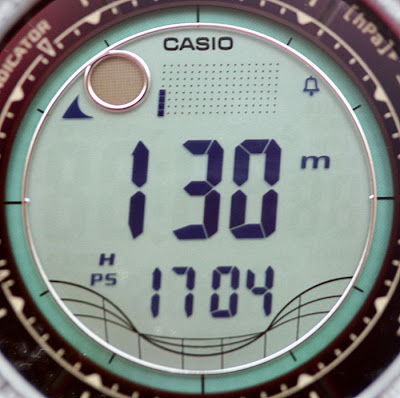You rotate trough the following modes by pushing the
mode button :
(notice that some of the crystals in the pictures turn blue. In reality they're all black. I believe it has to do with some kind of polarization in the photo lens)1. TIDE & MOON DATA Mode. When you enter the tide/moon data mode, you always get the tide at 6:00 of the current day.
When you enter the tide/moon data mode, you always get the tide at 6:00 of the current day.

You can now check hour by hour the evolution of the tides.
You can also check the tide on a different day. (future or past)
The tides are set in the factory and may be different from your local situation.
It's important to determine your "Home City" when you first get the watch .
I looked up the tides on the Internet for the river that runs trough Antwerp : "The Schelde".
After you have determined when high tide occurs on a certain day, you store that data in the watch . Then the tide graph will always show the correct tides. I check it whenever possible and I must say it runs smoothly.
Here's how to read the tide graph :

This is the moon phase indicator. It takes 29,53 days for the moon to complete a full cycle. It's full moon in the picture below.

 Depending on where you are on the earth the bright and dark part of the moon may be inverted. You can easily invert this on the watch too.
Depending on where you are on the earth the bright and dark part of the moon may be inverted. You can easily invert this on the watch too.
2. COUNT DOWN TIMER Mode.

Personally I find this a practical feature. The last 10 seconds of the countdown the watch beeps every second. Letting you know the preset time is coming to an end.
When I put a pizza in the oven for 13 minutes. I set the count down timer of the watch on 13 minutes and then I
go mostly in the garden. I will now know when the pizza is ready without constantly having to look at the watch.
3. STOPWATCH Mode 
24 hour stopwatch with capability of 1 split time.
4. WORLD TIME Mode
Displays the current time in 33 cities (29 time zones) around the world.
London time in the picture above and the time in Sydney at the same moment below.
5. ALARM Mode.
If you want the watch to give a short beep on top of every hour, you can put the hourly signal on and a small chime symbol appears. (it is part of the alarm mode)

You can set 5 alarms a day. (this is alarm 1 - it is off)

Alarm 5 is also off.

When one or more alarms are set, the symbol you see underneath the chime appears. Those 2 symbols are also visible in time keeping mode.
6. DATA RECALL Mode. 
It shows the altitude record. (the
maximum value or the
highest altitude reading) It gives date and time of the maximum reading. You can easily reset it. To me this feature is a bit misleading because the altitude readings are based on barometric pressure. So it is possible that even if you don't move the watch you get a new highest altitude because of dropping barometric pressure.
More on that in the next post when I cover the barometer feature.
7. RECEIVE Mode.
Radio-controlled Atomic Timekeeping is something great. Most digital watches have a 15-20 secs deviation a month. This watch keeps the correct time when it is able to receive the time calibration signal.
My watch is set to automatically receive the signal.

The display shows the time and the date of the last successful time calibration.
It doesn't show from
witch transmitter it received the signal. (some G-Shocks do). I know that for Belgium it is the German transmitter in
Mainflingen.

This concludes a quick run trough the different modes.
My next post w
ill cover the
ALTImeter -
BAROmeter -
COMPass.
 A package came in. Yeah my new helicopter has arrived.
A package came in. Yeah my new helicopter has arrived. Let's see what's in this box. Some spare parts and a training set.
Let's see what's in this box. Some spare parts and a training set. Nice picture on the box. Would the content of the box be as good ?
Nice picture on the box. Would the content of the box be as good ? Flying manual + Simulator software + List of all parts used in the Honeybee FP.
Flying manual + Simulator software + List of all parts used in the Honeybee FP.




















 When you enter the tide/moon data mode, you always get the tide at 6:00 of the current day.
When you enter the tide/moon data mode, you always get the tide at 6:00 of the current day.


 Depending on where you are on the earth the bright and dark part of the moon may be inverted. You can easily invert this on the watch too.
Depending on where you are on the earth the bright and dark part of the moon may be inverted. You can easily invert this on the watch too.
 24 hour stopwatch with capability of 1 split time.
24 hour stopwatch with capability of 1 split time. Displays the current time in 33 cities (29 time zones) around the world.
Displays the current time in 33 cities (29 time zones) around the world. 


















